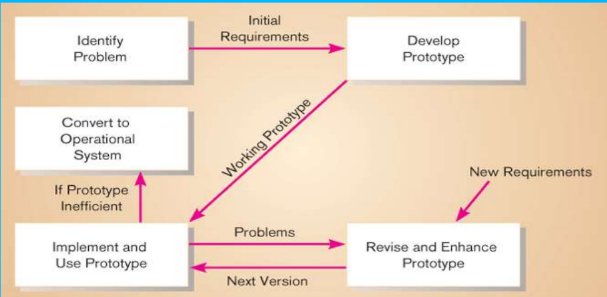Different Approaches to
Improving Information Systems Development
Several different
approaches have been developed in the continuous effort to improve the systems
analysis and design process. The two important approaches are prototyping and joint
application development (JAD).
Prototyping
Prototyping is a form of
rapid application development (RAD). Prototyping is a rapid, iterative, and
incremental process of systems development in which requirements are converted
to a working system that is continually revised through close work between the development
team and the users. We can build a prototype with any computer language or
development tool, but special prototyping tools have been developed to simply
the process. A prototype can be developed with some fourth-generation language
(4GL), with the query and screen and report design tools of a database
management system, and with tools called computer-aided software engineering
(CASE) tools.
 |
| Prototyping |
In prototyping, the
analyst works with users to determine the initial or basic requirements for the
system. The analyst then quickly builds a prototype. When the prototype is completed,
the users work with it and tell the analyst what they like and do not like
about it. The analyst uses this feedback to improve the prototype and takes the
new version back to the users. This iterative process continues until the users
are relatively satisfied with what they have seen.
Ideally, the prototype
serves as a mechanism for identifying information system requirements. In this
case, we throw away the prototype (also called throwaway prototype) after
identifying requirements. The actual information system is developed with an
eye toward quality and maintainability based on the requirements.
Advantages:
- Useful for projects in
which user requirements are uncertain or imprecise.
- It encourages active user
and management participation.
- Projects have higher
visibility and support because of the extensive user involvement.
- Users and management see
working, software-based solutions more rapidly.
- Errors and omissions tend
to be detected earlier in prototypes.
- Testing and training are
natural by-products.
- It is more natural
process.
- It is most popular for
small to medium-size projects.
Disadvantages:
- It increases lifetime
cost to operate, support and maintain the system.
- It can solve the wrong
problems since problem analysis is abbreviated or ignored.
- The product may have less
quality because of speed in development.



Comments
Post a Comment
Subscribe Us and Thanks for visiting blog.